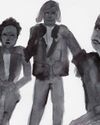For the first time in its longstanding history, revered Italian brand Max Mara rings its audience into its past in a retrospective Resort ’19 collection. Here, we discuss its past, present and future with Maria Giulia Prezioso Maramotti, the granddaughter of the house’s founding father.

“WE ARE KNOWN as the silent giant,” says Maria Giulia Prezioso Maramotti, Max Mara’s retail director for North America and granddaughter of the Italian house’s founder, in an email correspondence. The moniker “silent giant” reads appropriate for Max Mara, whose creative lead has largely ascribed to anonymity and the history of the house itself, less discussed.
For years, questions pertaining to the identity of its designer — who has been at the helm for three decades — drew a blank. The fashion set was acquainted with Max Mara as a quiet force in the industry, with its beginnings rooted in an Italian heritage. With the inconspicuous identity of its designer detracting nothing from the house’s visual language, it has solely been known for what it has to offer its customers.
Beyond its line-up of camel coats and unmistakable sophistication that is synonymous with its identity, there is much to be learnt about Max Mara. The house’s past, largely gone unacknowledged in its almost seven-decade long run was, for the first time, recognised at its Resort ’19 showcase, which was held at the Collezione Maramotti (the private collection of contemporary art of Achille Maramotti, the founder of Max Mara) museum in Reggio Emilia.
The history of Max Mara harks back to 1951, when senior Maramotti, then a 24-year-old law graduate, made the pivotal decision to carve a career out of his passion for haute couture passed down from his great-grandmother. Much like his resolve in deviating from a premeditated career in law, senior Maramotti's way of work at Max Mara deviated from the norm. At a time when clothing was still mostly handmade in Italy, his manufactured ready-to-wear preposition was an untried idea.
In the years following its introduction, Max Mara rose in the brand rankings, eventually taking its place amongst purveyors of luxury in Italy’s fashion industry.
Esta historia es de la edición November 2018 de T Singapore: The New York Times Style Magazine.
Comience su prueba gratuita de Magzter GOLD de 7 días para acceder a miles de historias premium seleccionadas y a más de 8500 revistas y periódicos.
Ya eres suscriptor ? Conectar
Esta historia es de la edición November 2018 de T Singapore: The New York Times Style Magazine.
Comience su prueba gratuita de Magzter GOLD de 7 días para acceder a miles de historias premium seleccionadas y a más de 8500 revistas y periódicos.
Ya eres suscriptor? Conectar

Look At Us
As public memorials face a public reckoning, there’s still too little thought paid to how women are represented — as bodies and as selves.

Two New Jewellery Collections Find Their Inspiration In The Human Anatomy
Two new jewellery collections find their inspiration in the human anatomy.

She For She
We speak to three women in Singapore who are trying to improve the lives of women — and all other gender identities — through their work.
Over The Rainbow
How the bright colours and lively prints created by illustrator Donald Robertson brought the latest Weekend Max Mara Flutterflies capsule collection to life.

What Is Love?
The artist Hank Willis Thomas discusses his partnership with the Japanese fashion label Sacai and the idea of fashion in the context of the art world.

The Luxury Hotel For New Mums
Singapore’s first luxury confinement facility, Kai Suites, aims to provide much more than plush beds and 24-hour infant care: It wants to help mothers with their mental and emotional wellbeing as well.

Who Gets To Eat?
As recent food movements have focused on buying local or organic, a deeper and different conversation is happening among America’s food activists: one that demands not just better meals for everyone but a dismantling of the structures that have failed to nourish us all along.

Reimagining The Future Of Fashion
What do women want from their clothes and accessories, and does luxury still have a place in this post-pandemic era? The iconic designer Alber Elbaz thinks he has the answers with his new label, AZ Factory.

A Holiday At Home
Once seen as the less exciting alternative to an exotic destination holiday, the staycation takes on new importance.
All Dressed Up, Nowhere To Go
Chinese supermodel He Sui talks about the unseen pressures of being an international star, being a trailblazer for East Asian models in the fashion world, and why, at the end of the day, she is content with being known as just a regular girl from Wenzhou.